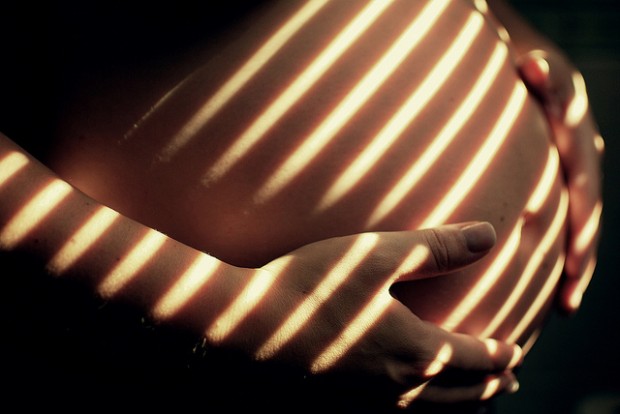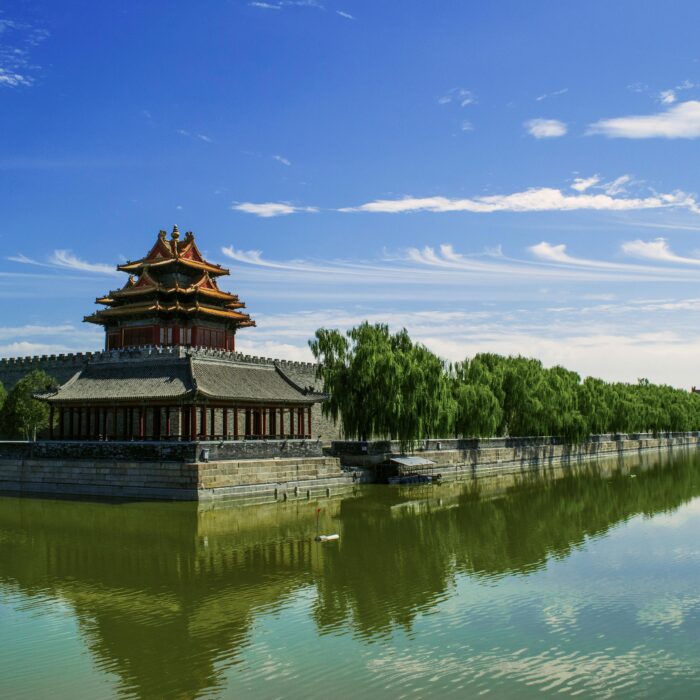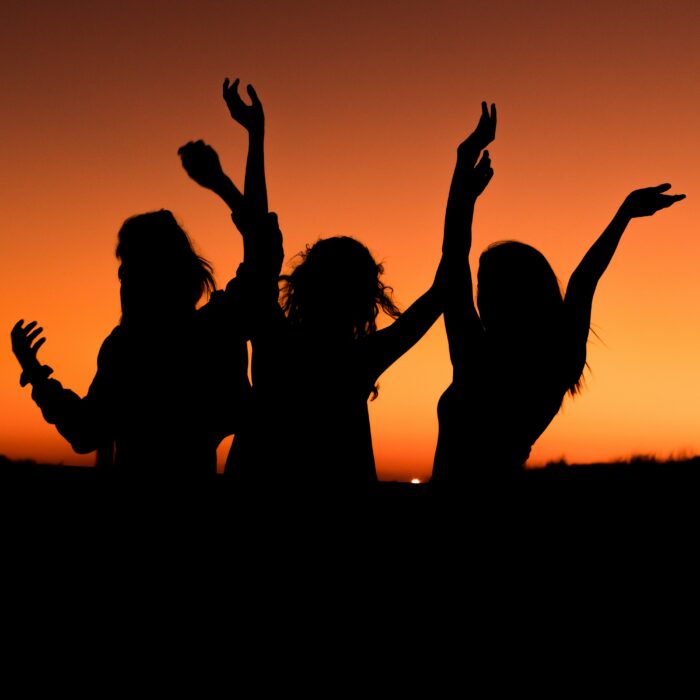You have no items in your cart. Want to get some nice things?
Go shopping
It was during the third trimester, at 34 weeks, that it happened. Overnight. There was no warning. I woke up one day and my belly was ringed with angry red fissures—as though my bump had been contour-ploughed by tiny angry red oxen. I had expected a few silvery lines on my hips. That’s what I was prepared for—that was the sacrifice I was willing to make for my baby. This was not a sacrifice—this was a horror movie.
“Calm down, this is totally normal,” the midwife told me. Tall and angular, she had five boys of her own—nothing dented her composure. She spoke quickly and had an opinion on everything.
“How can this be normal, I’ve never seen stretch-marks like these in a pregnancy magazine?”
“Have you ever seen stretch-marks in a pregnancy magazine?”
“Well, no.”
“That’s because those women are not really pregnant…they’re models with pillows up their dresses, they don’t get stretch-marks. They don’t get heartburn or incontinence or haemorrhoids either.”
“I don’t care about the stretch-marks.”
It was something else that was worrying me. “I think she’s sending me a message.”
“Who is sending you a message?” the midwife stopped her vigorous poking and massaging of my belly and looked at me—her eyebrows meeting fiercely over the bridge of her nose.
“The baby.”
She laughed, “If that’s how you want to think about it. ‘Hello Mummy here I am!’”
She wasn’t taking me seriously. I sat up a bit.
“I think she’s scared—she wants to get out.”
Why on earth had I decided to have a baby? Perhaps we should have considered adoption. Poor innocent child—a victim of my lousy genes.
“She’s tucked up very happily in there, there’s nothing for her to be frightened of.”
She firmly levered my shoulder back so I was lying flat again.
“Perhaps that’s why she’s frightened, maybe she’s…” I hesitated to say the word.
“Maybe she’s what…seasick? Scared of the dark?”
“Maybe she’s…claustrophobic.”
It was what I had been dreading but I’d been too afraid to imagine.
She looked at me in disbelief and then she snorted, nostrils flaring. “That’s ridiculous. Babies don’t get claustrophobic.”
“How do you know? You can’t prove that. She used to have lots of space to roam around in, but it’s getting pretty tight in there now. You can see that.” I indicated the stretched skin on my stomach. “Maybe that’s why some of them come out early—they can’t stand it in there any longer.”
She gave me a stern look. “Babies…do…not…get…claustrophobic.”
When I was 11 we went on a school camp somewhere in the Peak District—a place called ‘Heart of Adventure’, which sounded good but in reality was the same old thing: soggy socks, muddy shoes, dirty bathrooms, unappetising macaroni cheese by the bucket-load. We had to participate in various ‘adventurous’ activities to promote leadership or teamwork or something like that.
On the first day we did abseiling. I had never abseiled before and I was nervous. We hiked to the top of the cliff. To be honest it was more like a rocky slope—I could have probably climbed down without a rope. We each waited our turn to be strapped into the harness and to approach the ledge. The first bit was the tricky part—on the edge of the cliff you were supposed to stand with your back to the drop and lean backwards. I watched several girls try it with varying levels of fear and success until there was just one girl to go before me. Her name was Josie Grant and she had never been particularly nice to me. She was one of the popular girls but only by association and by attitude—she had long blonde hair, always beautifully plaited, but her eyes were too close together and there was no differentiation between her calves and her ankles. She allowed the guide to put the harness on her but as she approached the edge she collapsed into a heap of quivering, sobbing terror. I was fascinated that the prospect of a small drop could completely change someone’s personality and I watched her disintegration with some enjoyment. They removed the harness—she was not going to go anywhere near the edge without some form of tranquiliser—and then it was my turn. I had been nervous but as I looked at Josie Grant—still snivelling—I swallowed the fear I had possessed. I resolutely turned my back to the abyss, leaned backwards and stepped over the edge.
Later that afternoon we explored a cave. We walked down through a damp cavern dimly lit by fixed lanterns and we crowded around a small dark hole in the wall at the back of the cave.
“Right,” our guide announced cheerfully, “for this next bit you’ll need to crouch over as you walk, it gets a bit tight, but try not to touch the walls.”
Apparently he expected me to crawl into the small dark hole.
“It will be quite dark but if you just follow the person in front of you then you shouldn’t get lost,” he went on. “Follow me.”
A few of the boys rushed forwards and jostled to be the first in, the rest of us formed a queue and I watched as, one by one, my classmates were swallowed up by the tunnel. I started to feel hot and cold simultaneously; I had goose-bumps on my arms and my legs felt weak—I seemed to feel the weight of all the earth above the cave pressing down on my internal organs. And then the entrance gaped ahead of me. I told myself that it was perfectly safe; that the teachers wouldn’t let us do anything dangerous, and then I bent my knees and my shoulders and shuffled in. I could still make out the shape of the person in front of me but then someone entered the tunnel behind me and the last of the light from the cavern was extinguished. I became aware that I was blocked in on all sides. I was trapped. There were solid feet of rock and crowding bodies in between me and fresh air and light and freedom. I felt a wild shriek building up inside my chest. I had to get out immediately or I would lose control and start to scream and kick and bite my way out. I started to back out of tunnel.
“Hey!” The person behind me complained as my bottom connected with their face.
I swivelled, my hands clutching blindly, and shoved past them and the next person, and stumbled back out into the cavern. I was sweating and shivering. My stomach was churning as though I had been on a rollercoaster and I thought I might be sick. I realised that I was not physically capable of crawling into that dark narrow passageway—deeper and deeper under the crush of earth and rock.
This was the first time I realised that I was claustrophobic.
There had been other incidents since then—incidents in lifts, in rush-hour trains and once in a changing room with a dress that was a size too small. I had learned to live with my disability. As soon as I felt the beginnings of the cold sweat on my forehead, the churning in my stomach, I would just leave—let my legs lead me out of the situation. If I was trapped—the doors had closed and there was no way to escape—then I had a visualisation technique that I would use. It involved closing my eyes, imagining myself to be Maria in a mountain-top meadow in the Alps, and quietly singing ‘The Hills Are Alive’ until I was free.
It was not only physical walls that I felt constricted by; sometimes it was my life that seemed to be closing in on me. Sometimes I had the feeling that I was trapped in a relentless rut of a routine: getting up in the morning, going to work, eating, sleeping—the same things over and over again. I would be immobilised by the fear that it would always be this way, or worse, that my life would reduce—spiralling inwards and would only ever get progressively more boring and restrictive.
Two weeks later I called the midwife again.
“She wants to get out of there. She can’t take it much longer.”
I was desperate; I could hardly sleep at night. Every time I felt her move I imagined her little hands and feet hammering against the suffocating walls of my uterus, her head ramming uselessly against my unyielding cervix. And what about life beyond? What if she felt, as I sometimes did, trapped by life itself—the façade of choice that thinly veiled a reality limited by circumstance and obligation, and habit and fear?
“Calm down, she’s fine,” the midwife placated me. “It’s you I’m worried about. If you get yourself into a panic then your blood pressure goes up and that’s not good for either of you.”
“But she’s the one making me panic. She wants to come out, I know my baby. I know what she needs.”
The midwife’s eyes rolled so loudly I could hear them over the phone. “She needs to stay exactly where she is for another couple of weeks at least.”
At 37 weeks she decided she’d had enough—she pulled the plug. I woke up in the morning with the strange sensation that something was about to happen. I leapt out of bed, as much as a pregnant woman can leap. As I lumbered towards the bathroom something trickled down my legs and formed a puddle on the floor. It was her signal.
“She’s coming out.” I told my husband.
“I told you…she’s fine, she’s not claustrophobic—you’re projecting.” He said; his eyes still closed.
“No—my water’s broken. We need to go to the hospital.”
In between the contractions I sang to encourage her.
“Climb every mountain,” I sang. “Raindrops and roses and whiskers on kittens; something and something and something with mittens.”
By the end I was just singing one line: “then I don’t feel so bad”, over and over again. But I did feel bad. I had never felt this bad before—as though I was trapped in my own body and desperately needed to escape. And I knew that she must be feeling the same.
“I can see the top of the head, one big push.” The midwife was ruthlessly cheerful—up to her elbows in my agony.
“Right, the head is out. Hold on a minute, don’t push; let’s just get the cord off. There we go, OK, one more push.”
I tried to make sense of her running commentary. “Was the cord around her neck? Is she alright?”
This was it—my baby was being strangled by her own umbilical cord. She would be blue and limp.
“She’s fine, just one loop, I’ve got it off now. It’s very common. One more push…”
“That’s why she needed to get out. She was choking!”
“It’s very common. It’s not a problem. Time to push now…”
I held my baby.
“Freya, you’re free now.” I told her.
Her little eyes shone, peered into the expanse of this strange new world.
“I’m so sorry Freya— it must have been awful. I know what it feels like to be stuck somewhere—trapped. But you’re free now.” I loosened the swaddling a bit.
“And there are times you’ll be afraid—there will be lifts. But you can take the stairs. There will be trains—but you can walk or drive if you want to. Life is not easy Freya, it can be boring and monotonous and restricting. But there are good things too—there’s the sea, and the sky and there are mountains to climb, Freya. There are mountains.”

About Rebecca Rouillard
Rebecca Rouillard was born in Oxford, grew up in Durban, South Africa and now lives in London. She's had several short stories published and is currently working on a novel. She is the Managing Editor of the Birkbeck Writers’ Hub.





An author worth watching: Then I Don’t Feel So Bad | Litro https://t.co/EdtG1WbOFO
I have a new short story up on the Litro website this week – ‘Then I Don’t Feel So Bad’ https://t.co/kXUOPeSRms @LitroMagazine